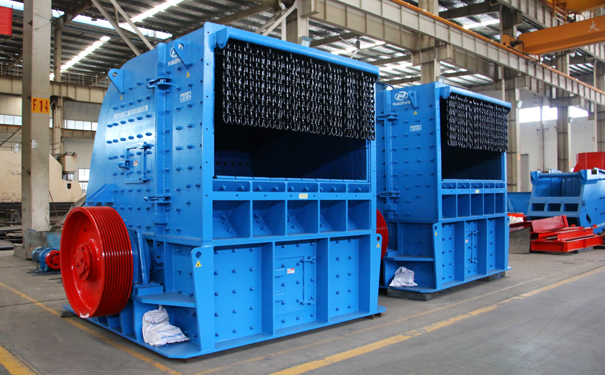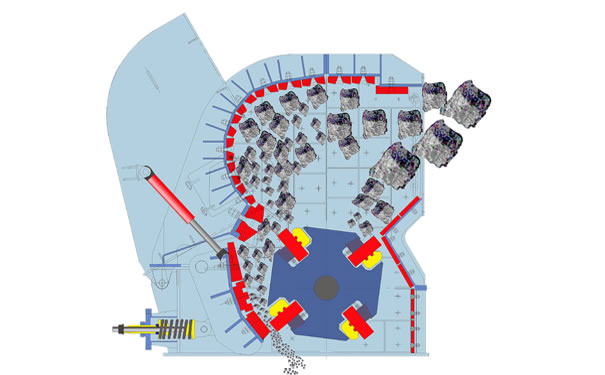The impact crusher is mostly used for the secondary crushing of the production line. With its large and large feed inlet, the feed size is large, and the heavy-duty rotor structure makes it more efficient, more productive, lower energy consumption, and easy to operate the features of convenient maintenance are well received by customers. The biggest feature is that the crushed material products have good grain shape and stable gradation. This is the key factor for whether the gravel can be sold at a good price. If you want to produce sand with good product size, you must first understand what factors affect the product size?

The impact crusher has a simple structure and is mainly composed of a frame, a transmission mechanism, a rotor, a hammer, and an impact plate. Specific performance is as follows:
(1) The rotor is the source of the inertial impact force during the crushing process. Therefore, the hammer head and the rotor need to be rigidly connected, and the rotor mass must be heavy enough.
(2) The counterattack plate and the hammer are the direct force-bearing surfaces in the crushing process, and often need to withstand the huge impact force brought by the rotor. Therefore, counterattack plates and hammers are often made of high manganese steel or other wear-resistant materials.

Influence of own performance on product granularity
(1) Impact speed
The impact speed of the impact crusher is the rotor speed, which has a greater impact on product granularity, production capacity, plate hammer wear and so on.
Generally speaking, when the impact speed is increased, the impact force of the hammer, the counterattack force of the counter plate and the collision force between the materials will increase, and the product particle size will become finer. At present, the general impact velocity is 15-45m / s. When used as coarse crushing, the impact velocity should be taken as a small value; on the contrary, when used as fine crushing, it should be taken as a large value. In addition, when crushing ores with larger hardness, the rotor speed should also be adjusted appropriately.
(2) Discharge gap
The gap of the discharge port is the minimum gap between the counter plate and the hammer. It is generally believed that the maximum particle size of the impact crusher product should be determined by the size of the gap. This is because the material crushed by the impact crusher is generally cubic. When the impact force is sufficient, the material entering the crusher will be fully crushed, and there are few large stones squeezed out of the discharge port. However, when the abrasion of the hammer is more serious, if the amount of wear is greater than 60% to 70%, the situation is different. At this time, the impact force of the contact surface between the rock and the hammer will drop greatly, and a considerable part of the material cannot be broken in time. Since the impact plate of the general impact crusher is equipped with a safety device to prevent unbreakable materials (such as cast iron) from entering the person and damaging the crusher, the part of the material will be driven by the high-speed rotating rotor to raise the impact plate Extruded from the discharge port.
(3) Hammer wear
The impact of plate hammer wear on product particle size changes is also great. From the perspective of production practice, the particle size of the product is roughly proportional to the degree of wear of the hammer, that is, the more severe the wear of the hammer, the larger the particle size of the product; otherwise, the smaller. This is because when the hammer is not worn, the edge of the hammer is in line contact with the rock, the rock has the largest impact force per unit area, the strongest crushing ability, and the finest product size; after the hammer is worn, the rock and the hammer The contact also gradually changes to surface contact, and the greater the amount of wear, the larger the contact surface, the smaller the impact force per unit area, the weaker the crushing capacity, and the coarser the product size, although the impact speed of the counterattack breakage does not change much at this time.
(4) Impact plate shape
When the impact crusher is used for crushing, it is not only crushed by the impact force of the hammer, but also by the impact force of the material on the impact plate. Therefore, the impact plate shape also plays an important role in the crushing of materials. Comparing the counter-attack plate with a serrated surface and the flat counter-attack plate, due to the impact of the rock on the serrated tooth edge, it can produce a larger counter-force and local specific pressure than the plane. In addition, because the facet of the zigzag impact plate forms an inclination with the bottom surface of the impact plate, the residence time of the rock in the crushing cavity is increased. Therefore, the zigzag impact plate can significantly improve the material crushing ratio and output compared with the planar impact plate. Under the same conditions, the serrated surface impact plate has a finer product size than the planar impact plate, and its over-crushing phenomenon It is also more serious.
In summary, when we choose the impact crusher, we should pay attention to the shape of the impact parts and the wear resistance of the hammer. At the same time, during the operation, we must appropriately adjust the rotor speed and the discharge port spacing. The product granularity has a great influence.

